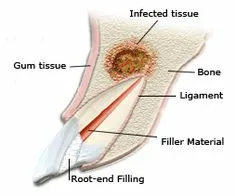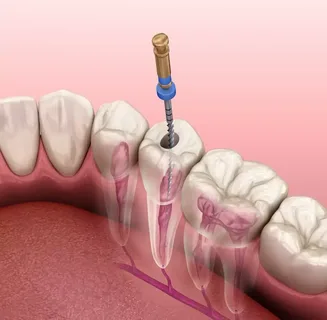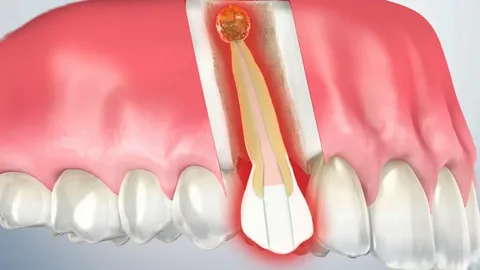Apicoectomy
An apicoectomy is a dental surgical procedure designed to treat infections or complications that persist after a root canal treatment. It is typically performed when a root canal has failed to resolve an infection at the tip of the tooth’s root or if there is a persistent infection or cyst that cannot be treated through conventional methods.
When is an Apicoectomy Needed?
Apicoectomy is usually recommended when:
- Infection persists: After a root canal treatment, infection remains at the tip of the tooth’s root.
- Root canal failure: If the root canal treatment does not completely remove the infection or if the tooth develops new issues.
- Apical periodontitis: This condition occurs when there’s inflammation or infection around the tip of the tooth’s root.
- Cysts or abscesses: If these form at the root tip and cannot be addressed with traditional root canal therapy.
- Anatomical issues: Some teeth have unusual root shapes or extra canals that are difficult to clean, requiring surgical intervention.
The Procedure
Preparation: The procedure is typically done under local anesthesia to ensure the area around the tooth is numbed. Sedation options may be offered for anxious patients.
Incision: The dentist or endodontist makes a small incision in the gum tissue near the affected tooth to expose the bone and root tip.
Root Tip Removal: The tip of the infected root (the apical portion) is removed, along with any infected tissue, such as an abscess or cyst, that may be present.
Cleaning and Sealing: Once the infected area is cleared, the root canal is cleaned thoroughly. The remaining root canal is sealed with a filling to prevent future infections.
Suturing: The gum tissue is then sutured back in place, and the area is allowed to heal.
Recovery
- Post-surgical care: After the procedure, you may experience some swelling, discomfort, or mild pain, which can be managed with pain medication and over-the-counter anti-inflammatory drugs.
- Follow-up: A follow-up visit is typically scheduled to ensure proper healing and that no complications arise.
- Healing time: Full recovery may take a few weeks, but the area should improve gradually within the first few days.
Success Rates and Considerations
- The success rate for apicoectomy is generally high, with many patients retaining their teeth for years after the procedure.
- The procedure is considered a last resort before extraction, as it aims to save the natural tooth and avoid the need for an implant or bridge.
Potential Risks
- Infection: Though rare, infections can occur after the procedure.
- Nerve injury: The procedure can sometimes cause damage to nearby nerves, though this is unusual.
- Tooth fracture: In rare cases, the tooth may become more fragile after surgery, requiring further treatment.
Key features about Apicoectomy

Root Tip Removal

Effective for Persistent Infections

Preserves the Natural Tooth
Frequently asked questions
Here are descriptions for FAQs about Apicoectomy to provide a clear understanding:
A root canal is a non-surgical procedure to remove infection from inside the tooth, while an apicoectomy is a surgical procedure to remove infection at the tip of the root if a root canal fails.
The procedure is performed under local anesthesia, so you shouldn’t feel pain during surgery. Some discomfort or mild pain is common during recovery, but it can be managed with medication.
The procedure typically takes about 30 to 90 minutes, depending on the complexity of the case.
Most patients experience swelling and discomfort for a few days, and complete recovery can take up to a few weeks.
Like any surgery, there are risks of infection, nerve damage, or incomplete healing, though these are rare.

